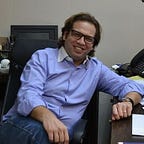My ADHD diagnosis opened the door to my best self
The greatest discoveries teach you there is so much more to learn.
An important discovery can be like observing an iceberg: only the surface is visible at first, until you go deeper and find out there’s 90% you knew nothing about.
It’s the same with Einstein’s revelation about relativity, and the state of the universe. Or unearthing Tutankhamun’s Tomb, only to begin exploring ancient Egyptian burial practices. Or finding a song you like in an entirely new-to-you genre.
Or being diagnosed with ADHD at the age of thirty-seven.
Experimenting with medication and CBT
After my diagnosis, I began numerous self-exploratory approaches and treatments.
My psychologist prescribed me medication. I had heard of many who found solace through pills, so it felt natural to start there.
The road was not easy, though.
I tried various medications, including Ritalin, which gave me an out-of-body experience. It felt as if I was watching myself from the outside — both bizarre and unsettling. This wasn’t what I was looking for. My aim wasn’t to distance myself from reality; rather, to gain better control over my ADHD.
Then, there were other drugs like Adderall and Vyvanse. Each one offered its own set of experiences. Some neutralized my zest for life, taking away the very essence of what made me “me”. I felt robotic, which is useful for students who take it to sit through an exam for four hours — but that’s not for me.
ADHD medication is a deeply personal journey. It’s crucial to understand what you’re aiming to achieve with it. I was seeking emotional control, the ability to manage overreactions and to maintain focus during long business negotiations.
Once I found the right medication, which is difficult to obtain in Israel, I found control over my ADHD.
My mind is usually utter chaos, but with my new medication, my chaos was calmed, and my emotional over-reactivity turned down, so I could function.
I suddenly understood better what it’s like for most people; instead of a million competing thoughts and concerns, I was able to have one thought at a time, and think clearly about it, in some kind of order. In truth, I found it less stimulating, but now I can get things done, instead of doing a million things and doing nothing at all.
I tried Cognitive Behavioral Training (CBT) too.
CBT wasn’t just about managing ADHD symptoms but about understanding and altering detrimental behavioral patterns. It was holistic, the focus not just on symptoms, but also on root causes. The exercises and sessions gave me tools I could use.
Working with a therapist helped me realize I was creating rules to account for my ADHD long before my diagnosis. Before leaving the house, I’ve always had list of five things I check I have with me: wallet, inhaler (because I have asthma), keys, mobile phone, and last but not least, my wedding ring.
My friends always notice me counting, as I check the items off in my head and on my hand. But it helps me ensure I’ve got what I need. Through my therapy, I realized I have many other rules like this that I use, and have since developed further, which informed the content of my book. Rules like “always write things down”, or my golden rule: don’t decide things on the spot.
Solving myself
Being naturally inclined toward creativity, I’ve taken what I learned about myself through my diagnosis and improved how I contribute to others daily. When you realize time-management is a challenge, because you’re naturally forgetful, you decide to keep a diary. You understand you have no concept of time, so you prioritize the time before meetings, for example.
I always tell myself and others, “Arriving on time is like being late.” So, if you have a meeting at eleven and you’ve arrived at eleven, then you’re late for that meeting.
Instead, I arrive seven minutes beforehand, so I can calm down, focus, and succeed in that meeting. That’s called valuing everyone’s time.
The more I consulted my symptoms through a professional lens, the more I realized what I could do to improve my behavior. (Things like creating a process, because in business, I believe, processes protect you.)
Understanding my unique personal challenges helped me put myself first. It opened up possibilities to handle my ADHD or connect with myself in ways I could not have predicted.
I’m thankful my diagnosis was just the starting point. Now, I hope my work will open the door for others seeking a similar journey.
If you enjoyed this article or want to find out more; about yourself, ADHD, business, or my book, please sign up to my mailing list.
